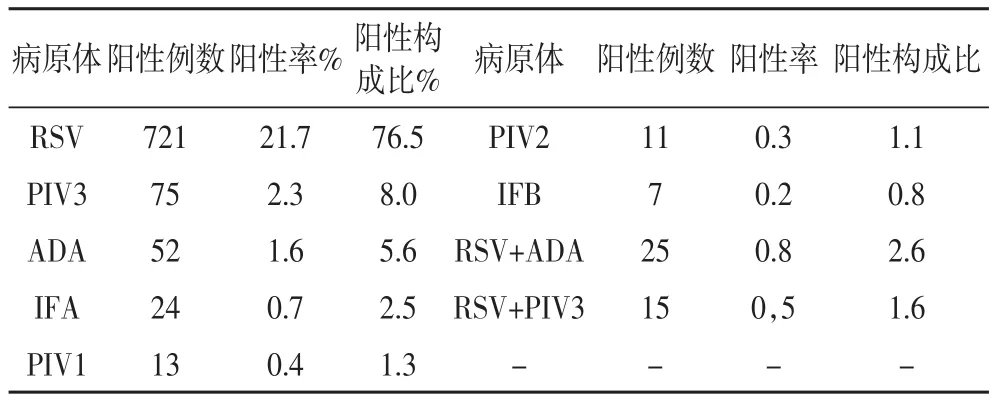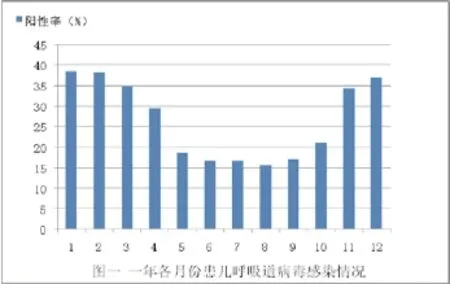小儿急性呼吸道感染3309例病毒抗原检测及分析
谢红军,李 征
(中南大学基础医学院,长沙 410013)
小儿急性呼吸道感染3309例病毒抗原检测及分析
谢红军,李 征
(中南大学基础医学院,长沙 410013)
目的:了解长沙地区一年四季不同年龄组小儿急性呼吸道感染病毒病原学特点及流行病学情况。方法:采用直接免疫荧光法(DIF)对2015年1月1日~2015年12月30日3309例长沙市中心医院儿科住院的急性呼吸道感染患者鼻咽分泌物进行七项呼吸道病毒联合检测。结果:943例患儿检出至少一种病毒,长沙地区呼吸道感染总阳性率28.5%(943/3309),其中呼吸道合胞病毒(RSV)721例(21.7%)、副流感3(PIV3)75(2.3%)、腺病毒(ADA)52(1.6%)、流感病毒A(IFA)24(0.7%)、副流感1(PIV1)13(0.4%)、副流感2(PIV2)11(0.3%)、流感病毒B(IFB)7(0.2%);RSV和ADA混合感染25例,检出率0.8%,RSV和PIV3混合感染15例,检出率0.5%;呼吸道合胞病毒(RSV)占总阳性病毒株的76.5%(721/943),其它病毒病原呈散在分布;新生儿期(出生-28天)、婴儿期(28d-1岁)、幼儿期(1-3岁)、学龄前期(3-6岁)、学龄期(6岁-)各组病源联检阳性率分别为37.8%、33.8%、32.3%、9.6%、6.3%,各年龄组病毒感染率比较差异均具有显著性;各年龄组病毒感染中,RSV阳性构成比分别为89.4%、80.8%、67.5%、50%、33.3%,年龄组间比较差异有显著性。长沙地区呼吸道病毒感染有明显的季节性,不同月份阳性率不同,四季当中,春、冬季阳性率较高,夏、秋季阳性较低。结论:病毒是小儿急性呼吸道感染的主要病原,长沙地区各年龄组小儿急性呼吸道感染主要为病毒病原RSV,年龄越小发病率越高,混合感染以婴儿、幼儿为主,呼吸道病毒感染显季节流行。
病毒病原学;小儿;急性呼吸道感染;流行病学
1 资料与方法
1.1 研究对象 为2015年1月1日~2015年12月30日诊断为急性呼吸道感染住院患儿共3309例,其中新生儿期249例、婴儿期1862例、幼儿期495例、学龄前期418例、学龄期285例。诊断标准参照实用儿科学第八版。研究对象分为5组:新生儿期(出生~28天)、婴儿期(28d~1岁)、幼儿期(1~3岁)、学龄前期(3~6岁)、学龄期(6岁-)组。
1.2 方法
1.2.1 标本采集 患儿入院诊断为呼吸道感染后,在未用药前采用专用一次性拭子取鼻咽分泌物:无菌一次性拭子从单个鼻孔插入7~8cm达鼻咽部,将拭子在鼻咽部。
1.2.2 病毒病原检测 用漩涡混合器将鼻咽分泌物打散,4000转/分钟离心5分钟,弃上清液留0.2ml,沉淀物调匀,点到玻片上,空气干燥后用丙酮固定。应用直接免疫荧光法,采用荧光标记的单克隆抗体检测RSV、ADV、IF(A、B)、PIF(1、2、3型)七种呼吸道病毒抗原,仪器为欧盟荧光显微镜,试剂由上海贝西生物科技有限公司提供,严格按照说明书要求操作。
1.3 判断标准 在荧光显微镜下显示苹果绿荧光的细胞为阳性细胞,被染成红色的细胞则为阴性细胞,40倍显微镜下每视野找到≥2个阳性细胞即为标本阳性。
1.4 统计学方法 统计分析应用医学统计软件(SPSS17.0)进行χ2检验。
2 结果
2.1 呼吸道病毒检测 3309例ALRI患儿中检出阳性病例943例,总阳性率28.5%(943/3309),其中呼吸道合胞病毒(RSV)721例(21.7%)、副流感3(PIV3)75(2.3%)、腺病毒(ADA)52(1.6%)、流感病毒A(IFA)24(0.7%)、副流感1(PIV1)13(0.4%)、副流感2(PIV2)11(0.3%)、流感病毒B(IFB)7(0.2%)。 RSV和ADA混合感染25例,检出率0.8%;RSV和PIV3混合感染15例,检出率0,5%。阳性构成比分别为呼吸道合胞病毒(RSV)721例(76.5%)、副流感3(PIV3)75(8.0%)、腺病毒(ADA)52(5.6%)、流感病毒A(IFA)24(2.5%)、副流感1(PIV1)13(1.3%)、副流感2(PIV2)11(1.1%)、流感病毒B(IFB)7(0.8%)、 RSV和ADA混合感染25(2.5%)、RSV和PIV3混合感染15例(1.6%)。检测结果见表1。

表1 儿童急性呼吸道感染的病毒类型及构成比 [株,(%)]
2.2 呼吸道病毒与年龄组的关系 新生儿、婴儿、幼儿、学龄前期、学龄期组均以RSV感染为主,RSV阳性构成比为89.4%、80.8%、67.5%、50%、33.3%,年龄组间比较差异有显著性(χ2=65.334,P<0.01);各年龄组ALRI患儿呼吸道病毒联合检测结果显示,病毒感染率分别为37.8%、33.8%、32.3%、9.6%、6.3%,各年龄组间病毒感染率比较(χ2= 182.888,P<0.01)具有统计学意义。见表2和表3。

表2 各年龄组间呼吸道病毒检出情况 [株,(%)]

表3 各年龄组间呼吸道病毒感染情况 [株,(%)]
2.3 混合感染情况 ALRI患儿呼吸道病毒联合检测结果显示,混合感染40例,混合感染率1.3%(40/943),其中RSV和ADA混合感染25例,RSV和PIV3混合感染15例。混合感染主要出现在婴儿,其次是幼儿,其它年龄组未见。
2.4 呼吸道病原流行情况 呼吸道病毒感染有明显的季节性,不同月份阳性率不同,最高月份在一月份,然后显下降趋势,5、6、7、8、9几月阳性率较低相差不大,从10月份开始阳性率又开始上升,四季当中,春、冬季阳性率较高,夏、秋季阳性较低。结果见表4和图1。

表4 一年各月份患儿呼吸道病毒感染情况 [株 %]

3 讨论
儿童下呼吸道感染(ALRI)病毒检测的阳性率各地区有所不 同。国内儿童 ALRI 病毒数据显示,上海地区总阳 性率是 40.5%[2],重庆地区总阳性率是 32.6%[4],昆明地区总阳 性率是 25.7%[3]。本研究显示,长沙地区儿童ALRI 患儿中 病毒的总检出率为 28.5%,其中RSV 检出率最高,其次是PIV3和ADV,与其他地区相关病毒研究相符[1,2,4]。通过七种呼吸道病毒病原联合检测,研究结果显示年龄越小呼吸道病原感染率越高,新生儿最高,40例混合感染中婴儿占77.5%,可能与婴儿免疫功能不完善有关,儿童组呼吸道感染率低于其它年龄组,可能与进年来儿童呼吸道感染的重要病原为非典型病原体有关[5]。
RSV 自 1956 年被分离出来,被认为是婴幼儿呼吸道病毒感染的 首要病原,特别是婴幼儿和〈3岁的儿童,由于母传抗体不能预防,出生不久的新生儿即可发病。本研究发现其中 RSV 检出率最高,总阳性病毒株的76.5%(721/943)进一步证实了呼吸道病毒感染以RSV为主[6],与临床特征相符。另外本地区PIV3和ADA也是引起呼吸系统疾病的重要病原体,ADA是引起儿童重症肺炎的重要病原,国内外曾有不同程度暴发流行,病情重、病死率高的报道,因此要加强监测。
不同季度儿童呼吸道病毒的感染状况也不同。本文研究发现,长沙地区呼吸道病毒的流行在第一、 四季度的感染率高于二、三 季 度,而 第 一、四 季 度 主 要是冬春两季,与其他文献报道的冬春季是呼吸道病毒感染的高 发 季 节 相 似。对呼吸道病毒病 原的检测,不仅为临床诊疗提供可靠依据,而且可以 指导医师 在各 流 行 季 节 针 对 不 同 病 毒 进 行 积 极 的 预防。
由于病毒治疗针对性强且大部分呼吸道病毒 越早治疗效果越好,加上呼吸道病毒病原学还会 因地区、医院、年份等不同存在差异[7],所以使用灵 敏度和特异性较高的方法对呼吸道感染的患儿进 行呼吸道病毒的快速检测尤为重要[8],同时准确的 诊断还可以减少额外的测试和缩短治愈的周期,因为一旦被确诊为病毒感染,患者则不需要进行抗生素治疗,减 少患者抗生素的使用,具有较大的临床意义。
直接免疫荧光法(DIF)可为儿童急性呼吸道感染提供准确、快速的病毒病原学信息,为尽早诊断疾 病、减少病毒传播、防止抗生素滥用提供可靠依据。另外,也有助于掌握该地区该病的流行病学特征,便于对疾病进 行有效监测,预防和控制大规模流行的爆发。
[1] 刘春艳, 谢正德, Gonzalez R, 等 . 儿童下呼吸道感染病毒病原学研究 [J]. 中国实用儿科杂志, 2009, 24(24): 270-273.
[2] 陆敏, 曾玫, 陆权, 等 . 上海地区小儿急性病毒性下呼吸道感染临床 流行病学特征 [J]. 中国抗感染化疗杂志, 2005, 5(3): 152-155.
[3] 樊茂, 吴茜, 倪林仙, 等 . 昆明地区儿童下呼吸道感染的病毒病原学 分析 [J]. 中国儿童保健杂志, 2007, 15(5): 539-541.
[4] Tsai H P, Kuo P H, Liu C C, et al. Respiratory viral infections among pediatric and outpatients in Taiwan from 1997 to 1999[J]. J Clin Microbiol, 2001, 39(3): 111-118.
[5] 许文波, 崔爱利, 史智扬, 等 . 江苏省不明原因轻型呼吸道传染病暴 发的病原学研究 [J]. 病毒学报, 2005, 21(5): 325-331.
[6] 胡芙蓉, 徐营, 李平, 等.2221 例婴幼儿呼吸道感染的检测分析[J].中华医院感染学杂志, 2010, 20(15): 2235-2237.
[7] Hara H, Hara H, Hironaka T, et al. Prevalence of specific neutralizing antibodies against Sendai virus in populations from different geographic areas: implication for AIDS vaccine development using Sendai virus vectors[J]. Hum Vaccin, 2011, 7(6): 639-645. [8]McTaggart LR, Wengenack NL, Richardson SE. Validation of the MycAssay Pneumocystis Kit for detection of Pneumocystis jirovecii in bronchoalveolar lavage specimens by comparison to a laboratory standard of direct immunofluorescence microscopy, real-time PCR, or conventional PCR[J]. J Clin Microbiol, 2012, 50(6): 1856-1859.
[9] Von RenesseA, SchildgenO, KlinkenbergD, et al Respiratory syncytial virus infection in children admitted to hospital but ventilated mechanically for other reasons[J] JMed Virol, 2009, 81(1): 160-166.
[10] Hall CB, Weinberg GA, Iwane MK, et al the burden ofr espiratory syncytial virus infection in young children[J], N Engl J Med, 2009, 360(6): 588-598.
[11] von RenesseA, Schildgen O, KlinkenbergD, et al, Respiratory syncytial virus infection in children admitted to hospital but ventilated mechanically for other reasons[J], J, Med Virol, 2009, 81(1): 160-166.
[12] Lees EA, Carrol ED, Gerrard C, et al. Characterisation of acute respiratory infections at a United Kingdom paediatric teaching hospital: observational study assessing the impact of influenza A (2009pdmH1N1) onpredominant viral pathogens[J]. BMC Infect Dis, 2014, 14: 343.
[13] Khamrin P, Thongprachum A, Shimizu H, et al. Detection of human bocavirus 1 and 2 from children with acute gastroenteritis in Japan[J]. J Med Virol, 2012, 84(6): 901-905.
[14] Bezerra PG, Britto MC, Correia JB, et al. Viral and atypical bacterial detection in acute respiratory infection in children under five years[J]. PLoS One, 2011, 6(4): e18928.
[15] 葛小丽, 陈洪敏, 程娟娟, 等. 无锡地区 340 例呼吸道病毒感染患儿的病原学分析[J]. 临床与病理杂志, 2015, 35(1): 31-35. doi: 10.3978/j. issn.2095-6959.2015.01.011 .
[16] 隋闳瞍, 王大燕, 舒跃龙. 呼吸道病毒多病原检测技术研究进展[J].病毒学报, 2013, 29(2): 238-240.
[17] 周蓓, 黄涛. 深圳地区5种呼吸道病毒感染的病原学分析[J]. 西部医学, 2012, 24(1): 158-160.
[18] 陈沁, 裘敏燕, 付永锋, 等.4种呼吸道病毒悬液芯片检测方法的建立[J]. 中国病原生物学杂志, 2013, 8(2): 97-99。
[19] Moriyama Y, Hamada H, Okada M, et al. Distinctive clinical features of human bocavirus in children younger than 2 years[J]. Eur J ePdiatr, 2010, 169(9): 1087-1092.
[20] 贾力. 儿童下呼吸道感染病毒的检测分析[J]. 中华医院感染学杂志, 2011, 21(16): 3386-3388. JIA Li. Detection of viruses causing lower respiratory tract infection in children[J]. Chinese Journal of Nosocomiology, 2011, 21(16): 3386-3388.
[21] 刘受祥, 刘百祥. 儿童呼吸道腺病毒感染临床分析[J]. 湖南师范大学学报(医学版), 2013(03): 78-81.
Detection and analysis of virus antigen in 3309 cases children with acute respiratory tract infection
Xie Hong-jun, Li Zheng
(School of Basic Medical Science Central South University, Changsha 410013, China)
Objective To understand the etiologic characteristics and epidemio-logy of acute respiratory infection in children in different age groups in Changsha area. Methods Nasopharyngeal secretions of 3309 cases of acute respiratory tract infection pediatric patients from January 1, 2015 to December 30, 2015 in Central Hospital of Changsha were detected by direct immunofluorescence (DIF) in seven respiratory virus detection, and the results were analyzed by x2test with SPSS17.0. Results 943 cases were positive with at least one of the seven viruses, and the total positive rate is 28.5%(943/3309); and the positive cases was shown to be respiratory syncytial virus (RSV) 721 patients (21.7%), parainfluenza 3 (PIV3) 75 (2.3%), adenovirus (ADA) 52 (1.6%), influenza virus A (IFA) 24 (0.7%), parainfluenza 1 (PIV1) 13 (0.4%), parainfluenza 2 (PIV2) 11 (0.3%) and influenza virus B (IFB) 7 (0.2%); 25 cases were RSV and ADA mixed infection with the detection rate of 0.8%; 15 cases were RSV and PIV3 mixed infection with the detection rate of 0.5%; positive rate of respiratory virus (RSV) was 76.5% (721/943), other viral pathogens are scattered in the distribution; Neonatal period (birth to 28 days), infancy (28d-1 years), early childhood (1-3 years), preschool children (3-6 years old), school (6 years old-), and the positive rate of the above pathogen groups was respectively for 37.8%, 33.8%, 32.3%, 9.6% and 6.3%. of differences of viruses infection rate in each age groups are significant; In all age groups, RSV positive ratio was 89.4%, 80.8%, 67.5%, 50%, 33.3% respectively, the differences between the age groups were also significant. There are obvious seasonal differences in respiratory tract virus infection in Changsha area. The positive rate was different in different months. The positive rate was higher in spring and winter and lower in summer and autumn. Conclusion Children acute respiratory infection in Changsha area is mainly by RSV, the younger the age, the higher incidence rate in children, mixed infection occured mainly in infants and young children. Respiratory tract virus infection transmission was related to the factor of season.
viral etiology; children; acute respiratory tract infection; epidemiology急性呼吸道感染是儿童常见的感染性疾病,严重威胁儿童健康。急性呼吸道感染可由多种病原体引起,临床症状也多相似。现已证明大部分的呼吸道感染是由细菌以外的病原体引起,其中病毒感染最常见。不同病毒的易感人群不同,且有不同季节和地区的流行性差异,对药物的种类和敏感性也不同。直接免疫荧光法(DIF)检测鼻咽分泌物七项呼吸道病毒抗原简单、特异,可早期、快速、准确诊断儿童呼吸道感染疾病。本文分析2015年1月1日至2015年12月30日长沙市中心医院儿科住院的3309例呼吸道感染患者鼻咽分泌物七项呼吸道病毒联合检测的结果,了解长沙地区一年四季儿童呼吸道感染病毒流行规律,为临床诊断、治疗、和预防提供依据和参考,减少抗生素的使用。
R725.6
A
1673-016X(2017)01-0052-04
2016-08-22
谢红军,E-mail:277613195 @qq.com

